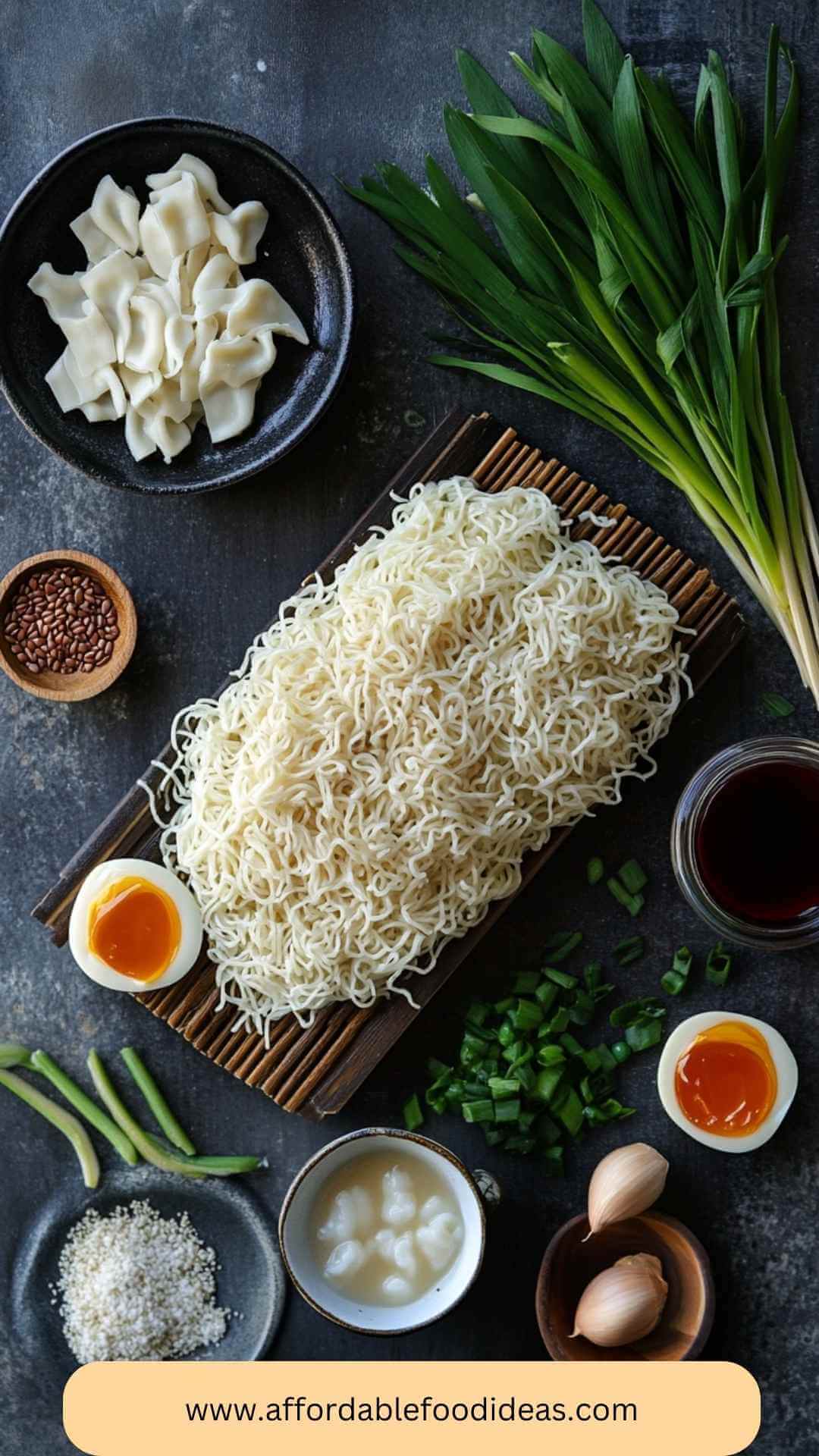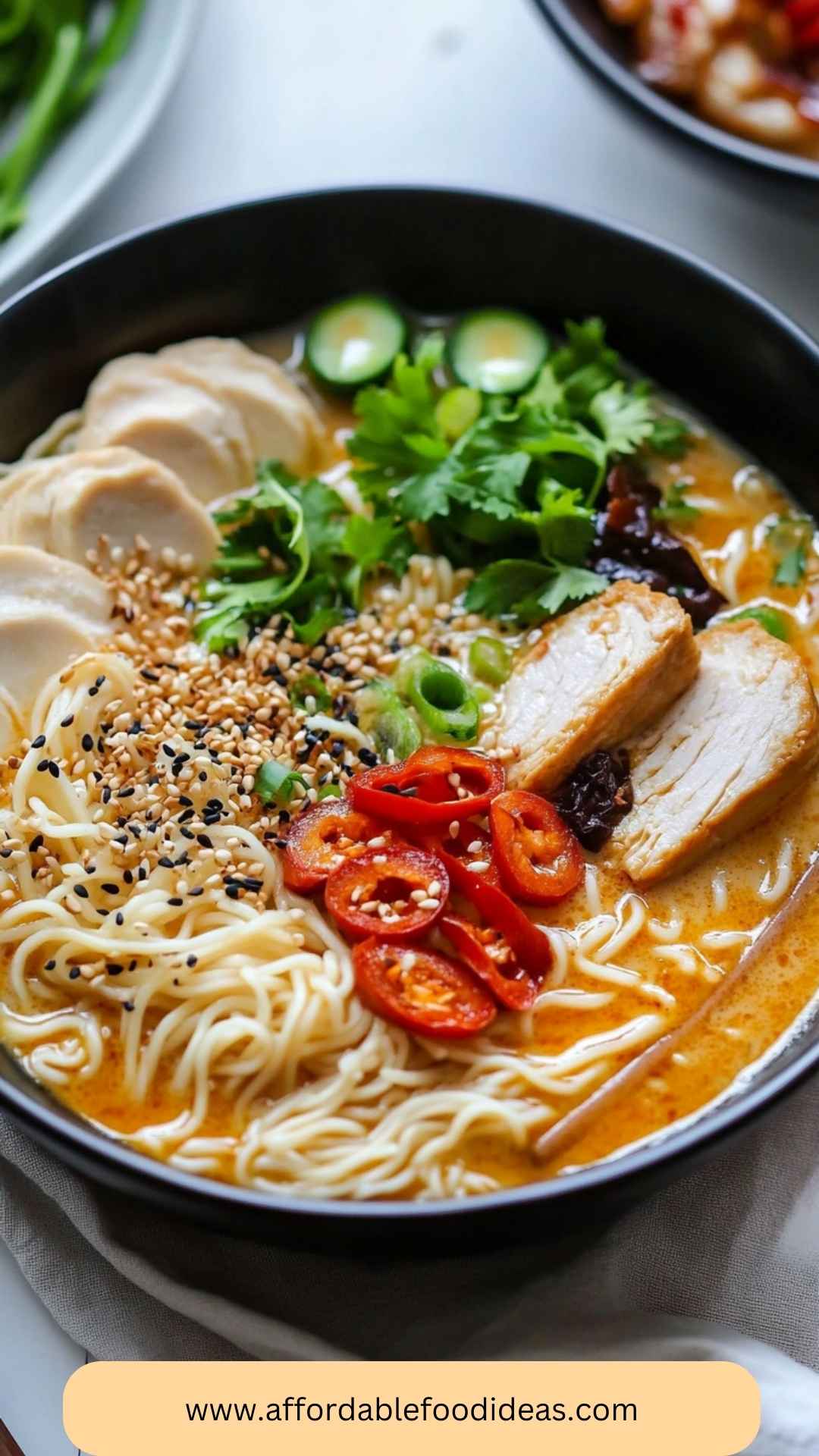some delightful sides that can enhance this dish. Think about vibrant, crunchy veggies that bring a balance to the meal.
Fresh cucumber sticks or a sweet carrot salad can add that necessary crunch. A side of edamame sprinkled with sea salt offers a nutritious bite, perfectly complementing the flavors of your ramen.
You might also want to consider a light, citrusy dressing for a refreshing salad. A quick mix of lemon juice, olive oil, and a hint of mustard can brighten your overall meal.
Pairing with a cold beverage, perhaps a sparkling water with a slice of lemon or a chilled green tea, will elevate your dining experience even further.

Why This Recipe Works?
1. High Protein Content:
Unlike traditional ramen, which often lacks protein, this recipe incorporates tofu and miso, providing a solid protein punch. The absence of meat doesn’t mean it’s lacking. With a well-balanced protein source, it’ll keep you full longer.
2. Rich Flavor Profile:
The combination of tamari soy sauce, miso paste, and a coconut-curry sauce delivers complex flavors. These ingredients merge beautifully, creating a harmony that dances on your taste buds. Each ingredient plays its part in making this dish irresistibly tasty.
3. Quick and Easy to Make:
With straightforward steps and minimal prep time, this ramen is perfect for busy weeknights. You can easily have dinner on the table in under 30 minutes. Just think about how often life doesn’t go according to plan. Quick meals can be lifesavers.
4. Versatile and Customizable:
One of the best aspects of this high protein ramen is its adaptability. You can swap out veggies, adjust the spice level, or even substitute the base. Got leftover vegetables? Throw them in! Want extra heat? Go for it!
How Does It Taste?
Imagine slurping noodles coated in a creamy, spicy sauce with a balance of savory depth and bright freshness. Tofu melds with the other ingredients, creating textures that surprise at every turn.
It has a delightful heartiness that comes from the vegan curry sauce combined with the umami notes from the miso. Truly a delightful bowl that leaves you wanting more!
What Sets This Recipe Apart From Other High Protein Ramen Variations?
This recipe distinguishes itself through its unique ingredient choices. Most high protein ramen recipes stick to traditional elements. Here, we introduce coconut cream and a blend of spices that many might not consider.
The addition of fresh herbs like cilantro or mint gives an extra burst of flavor. Incorporating two types of sauces also elevates the dish, resulting in layers of taste that make every bite enjoyable.
The Ingredients
To prepare this powerhouse dish, gather the following ingredients:
For the Noodles:
- 300g block of firm tofu
- 1 tbsp coconut or toasted sesame oil
- 1 tbsp black sesame seeds
- 1-2 tbsp tamari soy sauce
- ½ cup of vegetable-packed vegan curry sauce
- 2 portions of ramen or soba noodles
- 100g tenderstem broccoli (or asparagus), trimmed
- 1 tbsp miso paste
For Serving:
- 1 tsp tamarind paste
- 2 tsp chili oil (or 1 tsp chili flakes if you prefer more heat)
- ½ small red chili, finely sliced
- Fresh cilantro, parsley, or mint
- 1 spring onion (scallion), thinly sliced
- 2 tbsp coconut cream

Instructions
Step 1: Prepare the Tofu
Begin by draining your tofu and pressing out excess moisture. Cut it into bite-sized cubes. In a skillet, heat coconut or sesame oil over medium heat.
Once hot, add the tofu and sauté until golden brown on all sides. This should take about 8-10 minutes. A little crispy outside but soft inside is the goal.
Step 2: Cook the Noodles
While the tofu is cooking, bring a pot of water to a boil. Add the ramen or soba noodles and cook according to package instructions until al dente.
Drain and rinse under cold water to stop the cooking process. A simple step, but it makes a noticeable difference in texture!
Step 3: Add Flavorings
In the same pan with the tofu, reduce the heat. Pour in the tamari soy sauce and miso paste, stirring to coat the tofu evenly. This will allow the tofu to absorb all those flavorful notes. Then pour in the vegan curry sauce and mix well. Let it simmer for about 2 minutes because flavor takes time to develop.
Step 4: Toss in the Veggies
Introduce the tenderstem broccoli (or asparagus) to the pan. Cook for 3-4 minutes until they are just tender but still vibrant. Remember, we want to keep that crunch intact.
Step 5: Combine Noodles and Sauce
Gently fold in the cooked noodles, ensuring they are well coated in the sauce. The warmth of the other ingredients helps to infuse flavor into the noodles too.
Step 6: Prepare the Garnish
In a small bowl, mix the tamarind paste, chili oil (or flakes) for serving. This brings heat and balance in a simple way. You can adjust this to your preference.
Step 7: Serve It Up
Scoop out generous portions into bowls. Drizzle the prepared chili oil mix over the noodles. Sprinkle with fresh herbs, spring onions, and black sesame seeds.
Notes
- Switch the Protein: If you’re not a tofu fan, try chickpeas or edamame for that protein boost.
- Add More Vegetables: Spinach, mushrooms, or bell peppers can all be great additions—ideally whatever you have lying around.
- Spice Levels: Feel free to adjust the chili oil or add sriracha for an extra kick.
- Make it Gluten-Free: Use gluten-free noodles, as many options are available today, making this dish inclusive for everyone.
- Meal Prep Friendly: This dish keeps well in containers, making it a great option for lunches.
How Do You Store High Protein Ramen Noodles?
After enjoying your delicious bowl, store any leftovers in airtight containers in the refrigerator. They will stay good for about 3 to 4 days. When reheating, add a splash of water or broth to bring back some moisture and flavor.
Sides for High Protein Ramen Noodles
1. Cucumber Salad:
A refreshing cucumber salad adds a wonderful crunch. Slice cucumbers thinly and toss them with rice vinegar, sesame oil, and a pinch of sugar. The acidity complements the richness of the ramen beautifully.
2. Edamame Beans:
Boiled edamame sprinkled with sea salt is the perfect finger food. It’s protein-rich and fun to eat. Just pop those beans right out of the pods.
3. Kimchi:
Add a side of kimchi for a fermented twist. The tangy, spicy flavor delivers a delightful contrast to the creamy ramen. Plus, it’s packed with probiotics.
What Alternatives Can You Use for the Ingredients?
1. Tofu Alternatives:
If tofu isn’t your thing, consider tempeh. It’s just as protein-rich and has a firm texture.
2. Noodle Variations:
If you cannot find ramen, try using zucchini noodles or even quinoa for a twist. Each brings different texture and flavor profiles to the dish.
3. Curry Sauce Alternatives:
Can’t find vegan curry sauce? A mix of coconut milk and various spices (like curry powder and turmeric) can create a similar base. Experiment to suit your taste!
4. Fresh Herbs:
If you lack fresh herbs, a sprinkle of dried herbs can substitute in a pinch. Just remember, fresh herbs boost flavor significantly, so use them when you can.

Conclusion
High protein ramen noodles offer a special experience that combines nourishment and unbelievable flavor. It’s a dish that adapates to your tastes while still ensuring you feel satisfied and energized. With the ease of preparation, it’s perfect for any day of the week.
Try this recipe and explore your creativity in the kitchen. The dinner table will become a joyful place where you’re proud of what you serve.
So grab your ingredients, turn on some music, and create a bowl that warms the heart. You won’t regret it!
You’ll also like the following recipes!
- Ramen Noodle Cabbage Copycat Recipe
- How to Make Ramen Noodle Burger
- Best Ramen Noodles With Egg Recipe
High Protein Ramen Noodles Recipe – Affordable Food Ideas
I remember the first time I tried high protein ramen noodles. It was like a burst of flavor with a healthy twist. Now, ramen has always been a beloved dish. But this version takes it up a notch by packing in protein without sacrificing taste. It's one of those meals that you want to savor, not just eat.
Let’s embark on a culinary journey together. We’ll explore why this dish works wonders, how you can switch up the ingredients, and even some fun alternatives if you’re running low in your pantry. I’ll ensure you have everything you need to whip up a bowl that’s satisfying and nourishing.

Ingredients
For the Noodles:
For Serving:
Instructions
Step 1: Prepare the Tofu
-
Begin by draining your tofu and pressing out excess moisture. Cut it into bite-sized cubes. In a skillet, heat coconut or sesame oil over medium heat.
Once hot, add the tofu and sauté until golden brown on all sides. This should take about 8-10 minutes. A little crispy outside but soft inside is the goal.
Step 2: Cook the Noodles
-
While the tofu is cooking, bring a pot of water to a boil. Add the ramen or soba noodles and cook according to package instructions until al dente.
Drain and rinse under cold water to stop the cooking process. A simple step, but it makes a noticeable difference in texture!
Step 3: Add Flavorings
-
In the same pan with the tofu, reduce the heat. Pour in the tamari soy sauce and miso paste, stirring to coat the tofu evenly. This will allow the tofu to absorb all those flavorful notes. Then pour in the vegan curry sauce and mix well. Let it simmer for about 2 minutes because flavor takes time to develop.
Step 4: Toss in the Veggies
-
Introduce the tenderstem broccoli (or asparagus) to the pan. Cook for 3-4 minutes until they are just tender but still vibrant. Remember, we want to keep that crunch intact.
Step 5: Combine Noodles and Sauce
-
Gently fold in the cooked noodles, ensuring they are well coated in the sauce. The warmth of the other ingredients helps to infuse flavor into the noodles too.
Step 6: Prepare the Garnish
-
In a small bowl, mix the tamarind paste, chili oil (or flakes) for serving. This brings heat and balance in a simple way. You can adjust this to your preference.
Step 7: Serve It Up
-
Scoop out generous portions into bowls. Drizzle the prepared chili oil mix over the noodles. Sprinkle with fresh herbs, spring onions, and black sesame seeds.
Nutrition Facts
Servings 6
- Amount Per Serving
- Calories 176kcal
- % Daily Value *
- Total Fat 11.7g18%
- Saturated Fat 3g15%
- Sodium 336mg15%
- Total Carbohydrate 11g4%
- Dietary Fiber 3g12%
- Sugars 5g
- Protein 10g20%
* Percent Daily Values are based on a 2,000 calorie diet. Your daily value may be higher or lower depending on your calorie needs.
Note
- Switch the Protein: If you're not a tofu fan, try chickpeas or edamame for that protein boost.
- Add More Vegetables: Spinach, mushrooms, or bell peppers can all be great additions—ideally whatever you have lying around.
- Spice Levels: Feel free to adjust the chili oil or add sriracha for an extra kick.
- Make it Gluten-Free: Use gluten-free noodles, as many options are available today, making this dish inclusive for everyone.
- Meal Prep Friendly: This dish keeps well in containers, making it a great option for lunches.




